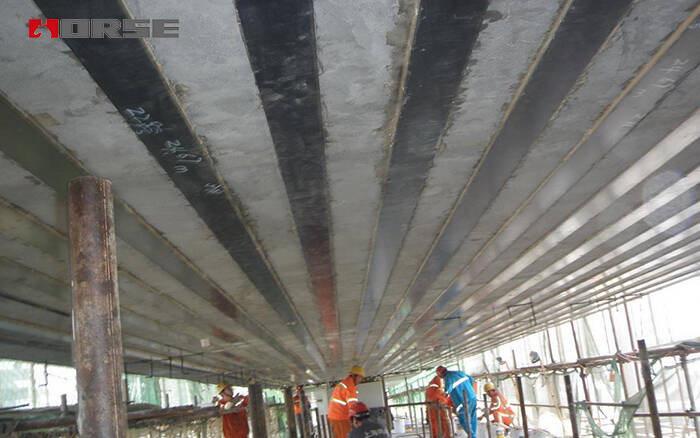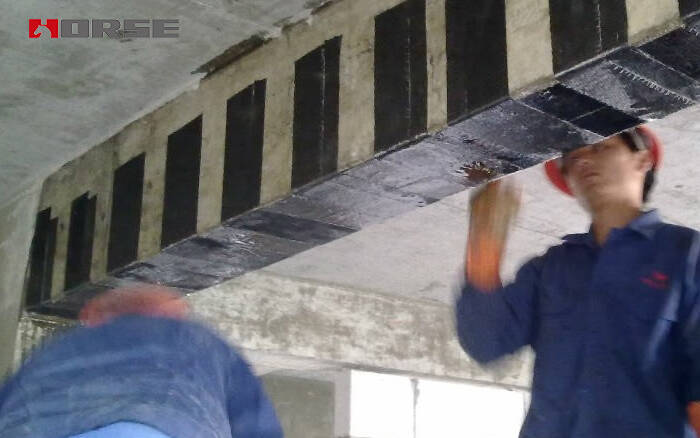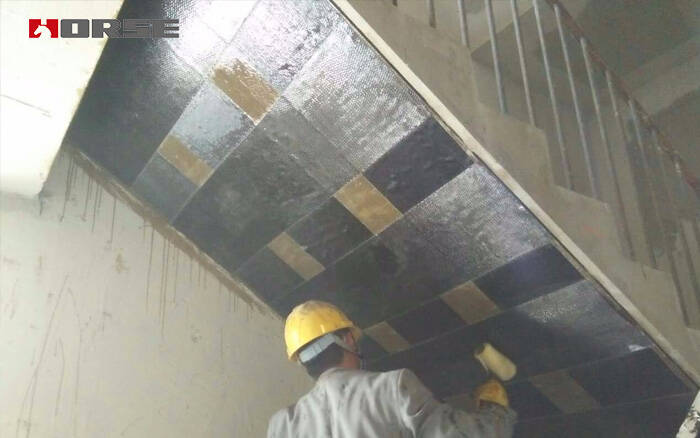Solutions
Horse Construction offers full range of structural strengthening materials with technical supports, documentation supports, products supports, project supports.
Structural Strengthening Reinforcement Technology In Building Construction

1. The importance of structural strengthening reinforcement technology application
Structural strengthening reinforcement technology mainly refers to the technology that uses corresponding materials and techniques to strengthen the building structure in order to improve the strength and seismic resistance of the building structure during the construction and subsequent maintenance of the house, or to target the weak location of the building structure. On the one hand, structural strengthening reinforcement technology is an important process for the construction of new buildings. Especially in the construction of contemporary large houses, it is necessary to adopt necessary structural strengthening reinforcement technology in the building structure system to improve the stability of the building structure. On the other hand, structural strengthening reinforcement technology plays an important role in the maintenance and repair of old buildings.
For example, in some relatively old housing constructions, due to the aging of components, the influence of the surrounding environment, and the shortcomings of traditional construction techniques, the stability of the building structure is affected, and even safety risks are caused. At this time, professional and technical personnel are required to conduct a comprehensive assessment of the building structure, and on the principle of ensuring feasibility, adopt a reasonable method to strengthen the structure. In this way, not only the stability of the building structure can be improved, but also the service life of the building can be prolonged. From the perspective of the development of the construction industry and the entire society, the application of structural strengthening reinforcement technology helps to avoid the shortening of the service life of housing construction due to various reasons. In turn, the waste of resources was effectively avoided and a key contribution was made to maintaining the stable development of society.

2, the application principle of building structure strengthening reinforcement technology
2.1. The principle of overall effect
The design and construction of housing construction need to strictly follow the relevant principles of structural mechanics. Especially for buildings with high height and large scale, the main structure must not only meet the weight of the building itself, resist a certain level of earthquake impact, but also resist the force exerted by the transverse wind. In the structure of a single building, changes in each part will affect the mechanical balance of the entire building structure. Therefore, when strengthening the structure, even if only a certain part is reinforced, the mechanical system of the entire building should be considered.
2.2. The principle of first judgment and then strengthening reinforcement
The structural strengthening reinforcement of a house building is not simply the strengthening reinforcement of damaged and aging locations. Before implementation, it is necessary to check specific parts of the building and even the entire structural system to clarify the cause of the problem. In this process, professional testing equipment and testing methods are needed. Some building maintenance personnel usually blindly use some materials for repair and strengthening reinforcement when they find cracks in the building structure. Not only can they fail to achieve an effective strengthening reinforcement effect, they may also fail to solve the fundamental problem, causing the problem to become more serious. Therefore, in today's building structure strengthening reinforcement operations, it is necessary for building engineers and structural mechanics technicians to inspect the entire building, clarify the cause of the problem, and then formulate a reasonable strengthening reinforcement plan. In addition, a sound, reasonable and rigorous quality control mechanism should be formulated in accordance with the characteristics of the actual internal environment of the building and the strengthening reinforcement construction process to avoid adverse effects on the building during the strengthening reinforcement construction.
2.3. Material performance and unity of original structure
In the construction of the building structure system, the types of materials, batches and construction techniques used are all uniform. In building strengthening reinforcement, if the properties of the materials used are quite different from the original structural materials, the structural stability is likely to be affected. For example, the cement grades used in different building constructions are different, and strengthening reinforcement means that if concrete pouring is to be carried out, it needs to maintain its consistency with the original structural concrete characteristics. Otherwise, after pouring, it is easy for the concrete expansion coefficient to be different from that of the original structural concrete, which will cause different deformations and cause damage to the building structure.
2.4. The scientific and environmental protection of the strengthening reinforcement scheme
Regarding the structural strengthening reinforcement of housing construction, the core purpose is to improve the stability of the building and prolong the service life of the housing. The structure of housing construction is more complex, involving many materials, process types and environmental factors. Therefore, the designation of the building structure strengthening reinforcement plan should strictly abide by the scientific principle to ensure that the stability of the building structure is improved on the basis of solving problems and meeting needs. In addition, in the era when Dangda pays attention to energy conservation and environmental protection, the structural strengthening reinforcement scheme used should follow the principle of reducing material consumption and building loss, and it can also combine structural strengthening reinforcement with building energy conservation and consumption reduction measures.

3. Application of structural strengthening reinforcement technology in housing construction
3.1. Prestressed strengthening reinforcement technology
Prestressing technology is an advanced technology emerging in the contemporary engineering field. It mainly uses the stress generated by the bending and stretching of steel bars to achieve a state of force balance as opposed to the stress generated by the building's own load and external factors. In view of the impact of house construction load and external prestress on the concrete structure, concrete can be used to generate axial tension on the structure, and then the force through horizontal tie rods can be introduced into the structure through steel bars, combined with concrete pouring and other processes. Allow building components to better withstand the bending moment generated by external loads. The advantage of this method is that it has a better effect on improving the stability of the building structure, and it is suitable for structural strengthening reinforcement of large unconventional modeling buildings. However, the construction difficulty of this technology is relatively high, and the requirements for the quality of the materials used in the construction and the level of craftsmanship are also relatively high. Of course, with the continuous development of modern technology, the application rate of prestressed strengthening reinforcement technology will gradually increase.
3.2. Outsourcing section steel strengthening reinforcement technology
Outsourcing strengthening reinforcement technology is one of the more commonly used technologies in the current building strengthening reinforcement, which can effectively improve the overall strength and tensile capacity of the building structure. The main method is to use section steel and steel plate to wrap the surface, corners and corners of concrete members, strengthen by drilling bolts, and pour epoxy resin and concrete mortar between section steel and concrete members to achieve the effect of strengthening the concrete structure. . This method is widely used in the structural strengthening reinforcement of building columns and load-bearing walls, and can effectively increase the cross-sectional area of concrete members, thereby increasing their supporting force. The advantages of outsourcing section steel strengthening reinforcement technology are simple construction, high efficiency and good strengthening reinforcement effect. However, in the construction, a lot of section steel materials are needed, the cost is relatively high, and the subsequent section steel anti-corrosion treatment requirements are relatively high. It is worth mentioning that the application of outsourcing section steel strengthening reinforcement technology and the use of a large amount of steel will increase the weight of the structure itself. Therefore, when using this technology, it is necessary to fully consider the load and mechanical state of the building structure itself. On this basis, an effective balance between the amount of section steel and the strengthening reinforcement strength should be done to avoid adverse effects on the building structure during strengthening reinforcement.
3.3. Section strengthening reinforcement technology
One of the advantages of the previously mentioned section steel strengthening reinforcement technology in application is that it can increase the cross-sectional area of building concrete components. Increasing the cross-sectional area is an effective method to improve the strength, stability and load capacity of concrete members. Therefore, in the building structure strengthening reinforcement technology, the interface strengthening reinforcement technology is also one of the very effective methods. In the specific implementation process, technicians calculate the load capacity of the building concrete beams, columns, load-bearing walls, structural slabs, etc., and then expand the reference to these structures in accordance with the design standards of the overall structure of the building. Under normal circumstances, the construction workers achieve the purpose of increasing the cross-sectional area of concrete components by laying steel mesh on the outside of the concrete structure and then pouring concrete. During construction, the original concrete structure needs to be processed, and anchors are used to connect the internal strengthening reinforcement of the component with the external strengthening reinforcement mesh into a whole. When pouring concrete, choose materials that are the same as or similar to the original component concrete signs and characteristics to ensure the consistency of the new and old concrete components after construction. Through interface strengthening reinforcement technology, the bearing capacity and shear resistance of the building structure can be improved.
3.4. Synthetic material strengthening reinforcement technology
Nowadays, modern engineering materials technology is fully advanced, and many new materials with many advantages have appeared. In the strengthening reinforcement process of some buildings, these synthetic materials can be fully utilized to reinforce the building structure. The more commonly used industrial synthetic materials in the strengthening reinforcement of building structures include carbon fiber cloth and glass fiber cloth. These materials have very strong strength, toughness and corrosion resistance. Wrap it on the surface of the building structure, which can improve the stability and shear resistance of the building structure, and also has good oxidation resistance and corrosion resistance. In addition, through the use of synthetic materials, the aesthetics of the building structure can be improved, which is a commonly used technology in many old building renovation and strengthening reinforcement projects today. It is worth mentioning that synthetic engineering materials represented by carbon fiber cloth, when used in building strengthening reinforcement, will not cause a large burden on the building structure due to its light weight. And it has the advantages of flexible use and simple construction.
You can find anything here you are in need of, have a trust trying on these products, you will find the big difference after that.

High strength carbon fiber reinforced polymer (CFRP) strip / laminate / plate for structural strengthening and concrete repair

Two-component epoxy modified epoxy structural strengthening adhesive for bonded steel plate to concrete

High strength, unidirectional carbon fiber sheet pre-saturated to form a carbon fiber reinforced polymer (CFRP) sheet used to strengthen structural concrete elements.